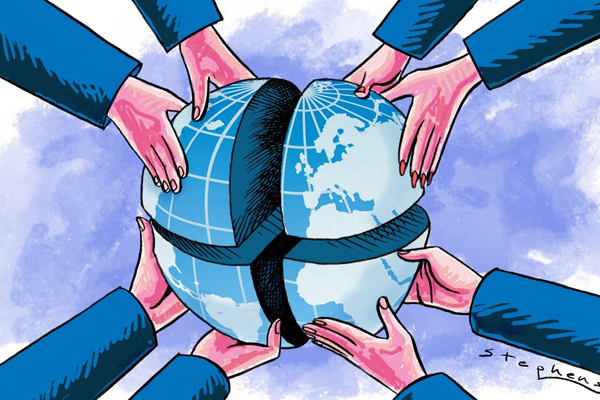【SCMP】Wang Huiyao: From Asean and G20 to Apec, as world leaders meet in person again, 3 reasons to root for multilateralism
November 29 , 2022From SCMP, 2022-11-29
■ The return of face-to-face meetings, the motivating effect of grave global challenges and the moderating influence of ‘middle power’ multipolarisation all point to a revival of global cooperation.
By Wang Huiyao | Founder of the Center for China and Globalization(CCG)
Over the past two weeks, Asia has played host to the most intense sequence of multilateral summits since the pandemic began, as national leaders gathered for meetings organised by Asean, the G20 and Apec. Although overshadowed by geopolitical tensions, the meetings marked a welcome return to in-person summit diplomacy, and the better-than-expected outcomes show hope yet for multilateralism.
The conclaves began in Phnom Penh with the annual summit of the Association of Southeast Asian Nations. At the first such in-person events in almost three years, Asean leaders took the positive step of agreeing in principle to admit East Timor as the 11th member of the organisation.
As leaders moved on to Bali for the Group of 20 summit, expectations were low after ministerial meetings in the run-up had failed to produce consensus. Earlier in the year, given fractures in the wake of Russia’s invasion of Ukraine, there was a question mark over whether the G20 could even go ahead or survive in its existing form.
In the end, the summit surpassed expectations by producing a joint declaration after intense negotiations, with leaders finding the compromises necessary to unite in declaring that “today’s era must not be of war” and pledging to uphold the multilateral system.
The summit also saw a positive face-to-face meeting between China’s President Xi Jinping and US President Joe Biden, their first as leaders, signalling a willingness to halt the downward trajectory of China-US relations.
In Bangkok, the 21 leaders of the Asia-Pacific Economic Cooperation forum also pledged to uphold and strengthen the rules-based multilateral trading system. Importantly, the group agreed on a multi-year work plan for an Asia-Pacific free trade area.
Reflecting on these three summits, three takeaways give reason for cautious optimism that multilateralism can yet be revived and play a major role in solving our challenges.
First, and perhaps most obviously, the return of in-person summit diplomacy is a welcome uplift for global cooperation. Virtual formats played a useful interim role at the height of the pandemic but was never a substitute for getting leaders in the same room. That is especially when it comes to interactions on the sidelines, often as important as the main event.
China’s return to diplomacy at the highest level was a further boost, both for the nation and the rest of the world.
In addition to Xi’s highly anticipated meeting with Biden, the Chinese leader met over a dozen other leaders at the G20 and Apec summits, including a warmer-than-expected first meeting with Japanese Prime Minister Fumio Kishida and his first meeting with an Australian prime minister since 2016.
Leaders got to meet their new counterparts for the first time or build on existing relationships, which can only help global cooperation.
The second takeaway is that as grave as our challenges are, the threat of escalating conflict and severe economic pressures on all nations seem to be focusing minds and increasing the willingness to engage and cooperate – out of necessity if nothing else.
The G20 summit was the second major one this year to surpass expectations after the 12th World Trade Organization Ministerial Conference in June surprised observers by agreeing on a plan to reform the organisation and its dispute settlement mechanism. The G20 statement reiterated support for this WTO reform plan, which will be critical to get the free trade agenda back on track and provide a much-needed boost for the global economy.
Third, and perhaps most significantly for the long term, the recent summits marked an acceleration of the trend towards multipolarisation in international diplomacy, and in particular, the rising influence of non-aligned “middle powers” to shape multilateral outcomes.
The middle powers represented at Asean, the G20 and Apec have huge stakes in avoiding a bifurcation of the global economy that might result from a new cold war. They don’t want to be forced to pick sides and many show a growing willingness and ability to build bridges and restore positive momentum for multilateralism.
Indonesia is a prime example. The country’s strategic heft and non-aligned credibility make it well-placed to bridge different camps. President Joko Widodo made a big political bet on the success of the G20 and has won praise for the deft diplomacy that kept the organisation alive and got it to a joint statement.
The Indian delegation reportedly also played a big role in achieving consensus on language in the statement, with the BRICS group (Brazil, Russia, India, China and South Africa) – as well as Indonesia – turning out to be crucial swing voters in securing the joint statement. One Indian official said it was “the first [G20] summit where developing nations shaped the outcome”.
There is scope for this trend to continue next year as middle powers continue to rise in stature, and India and Indonesia take over the presidency of the G20 and Asean, respectively. Brazil will host the G20 the year after.
Over in Sharm el-Sheikh at the COP27 UN climate summit, another middle power – the host Egypt – also won praise for helping to shepherd a historic financing deal for poor countries affected by climate change. But the ultimate failure to reach a commitment to phase down fossil fuels was a sobering reminder of the huge difficulties that remain in forging the global consensus needed to overcome our shared challenges.
Topical News See more







